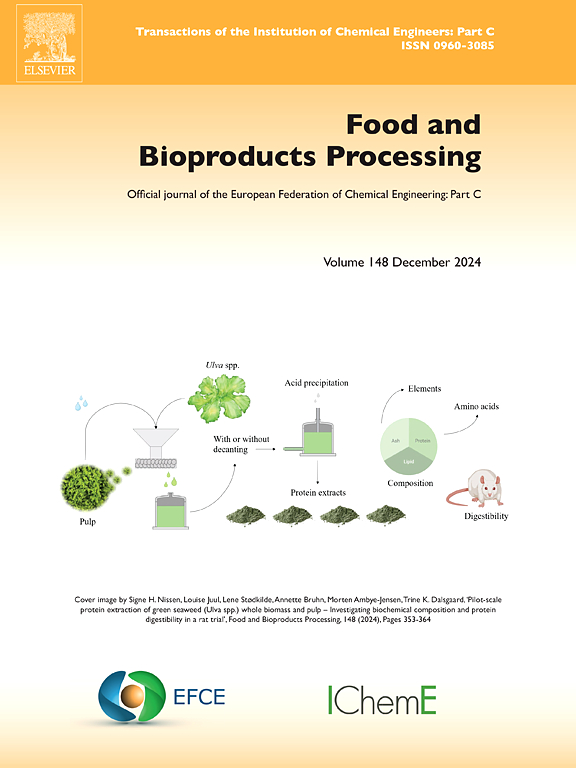基于乙酰丙酸和正庚烷的橡胶籽高效提油工艺的深度共熔溶剂
IF 3.5
2区 农林科学
Q2 BIOTECHNOLOGY & APPLIED MICROBIOLOGY
引用次数: 0
摘要
深共晶溶剂(DESs)在化学分离领域,特别是萃取过程中引起了人们极大的兴趣。研究了在正庚烷和乙醚存在下,以DESs为助溶剂,声能辅助提取橡胶籽油的工艺。以氯化胆碱(ChCl)为氢键受体,甘油(Gly)、乙酰丙酸(LevA)和二甘醇(DEG)为氢键给体,制备了三种DESs共溶剂。考察了萃取温度、种子与有机溶剂的质量比、萃取时间等工艺参数的动力学和优化。以ChCl:LevA(1:2)和正庚烷为原料,反应温度为50℃,反应时间为60 min,收率最高,为31.3 %。与纯正庚烷相比,用ChCl:LevA(1:2)可降低正庚烷存在下的萃取温度,油得率提高3.3 %。此外,采用一种真实溶剂的类导体筛选模型(cosmos - rs)来阐明DESs可以促进油滴周围保护蛋白膜的破坏机制。本文首次研究了以ChCl:LevA(1:2)作为橡胶籽油的天然助溶剂,该助溶剂有助于降低油提取过程中的能耗。本文章由计算机程序翻译,如有差异,请以英文原文为准。
Levulinic acid-based deep eutectic solvent and n-heptane for efficient oil extraction process from rubber seed
Deep eutectic solvents (DESs) have attracted significant interest in chemical separation, particularly in the field of extraction processes. This study investigated the process of sono-energy-assisted oil extraction from rubber seeds using DESs as co-solvents in the presence of n-heptane and diethyl ether. Three DESs co-solvents were prepared from choline chloride (ChCl) as the hydrogen bond acceptor and glycerol (Gly), levulinic (LevA), and diethylene glycol (DEG) as the hydrogen bond donors. The kinetics and optimization of the operating parameters, including temperature, the mass ratio of seeds to organic solvent to DES, as well as extraction time, were examined. The highest yield of oil of 31.3 % was achieved using ChCl:LevA(1:2) and n-heptane at a temperature of 50°C, and a contact time of 60 min. The extraction temperature can be reduced using ChCl:LevA(1:2) in the presence of n-heptane compared to pure n-heptane, while the oil yield was enhanced by 3.3 %. Furthermore, a conductor-like screening model for a real solvent (COSMO-RS) was employed to elucidate the extraction mechanism where DESs could facilitate the disruption of the protective protein membranes surrounding the oil droplets. This is the first study for application of ChCl:LevA(1:2) as natural co-solvent for oil from rubber seeds and this co-solvent can contribute in energy saving required for oil extraction.
求助全文
通过发布文献求助,成功后即可免费获取论文全文。
去求助
来源期刊

Food and Bioproducts Processing
工程技术-工程:化工
CiteScore
9.70
自引率
4.30%
发文量
115
审稿时长
24 days
期刊介绍:
Official Journal of the European Federation of Chemical Engineering:
Part C
FBP aims to be the principal international journal for publication of high quality, original papers in the branches of engineering and science dedicated to the safe processing of biological products. It is the only journal to exploit the synergy between biotechnology, bioprocessing and food engineering.
Papers showing how research results can be used in engineering design, and accounts of experimental or theoretical research work bringing new perspectives to established principles, highlighting unsolved problems or indicating directions for future research, are particularly welcome. Contributions that deal with new developments in equipment or processes and that can be given quantitative expression are encouraged. The journal is especially interested in papers that extend the boundaries of food and bioproducts processing.
The journal has a strong emphasis on the interface between engineering and food or bioproducts. Papers that are not likely to be published are those:
• Primarily concerned with food formulation
• That use experimental design techniques to obtain response surfaces but gain little insight from them
• That are empirical and ignore established mechanistic models, e.g., empirical drying curves
• That are primarily concerned about sensory evaluation and colour
• Concern the extraction, encapsulation and/or antioxidant activity of a specific biological material without providing insight that could be applied to a similar but different material,
• Containing only chemical analyses of biological materials.
 求助内容:
求助内容: 应助结果提醒方式:
应助结果提醒方式:


